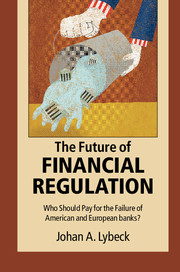Book contents
- Frontmatter
- Dedication
- Contents
- List of figures
- List of tables
- List of boxes
- Preface
- Acknowledgements
- List of abbreviations
- Introduction
- Part I A chronological presentation of crisis events January 2007 – December 2014
- Part II Bail-out and/or bail-in of banks in Europe: a country-by-country event study on those European countries which did not receive outside support
- Part III Bail-out and/or bail-in of banks in Europe: a country-by-country event study on those European countries which received IMF/EU support
- Part IV The TARP program and the bailing out (and bailing in) of US banks
- Part V Summary of the micro studies
- Part VI Political and regulatory responses to the crisis: to bail out or to bail in, that's the question
- Conclusion: toward host-country supervision and resolution?
- Addendum
- Bibliography
- Index
Conclusion: toward host-country supervision and resolution?
Published online by Cambridge University Press: 05 February 2016
- Frontmatter
- Dedication
- Contents
- List of figures
- List of tables
- List of boxes
- Preface
- Acknowledgements
- List of abbreviations
- Introduction
- Part I A chronological presentation of crisis events January 2007 – December 2014
- Part II Bail-out and/or bail-in of banks in Europe: a country-by-country event study on those European countries which did not receive outside support
- Part III Bail-out and/or bail-in of banks in Europe: a country-by-country event study on those European countries which received IMF/EU support
- Part IV The TARP program and the bailing out (and bailing in) of US banks
- Part V Summary of the micro studies
- Part VI Political and regulatory responses to the crisis: to bail out or to bail in, that's the question
- Conclusion: toward host-country supervision and resolution?
- Addendum
- Bibliography
- Index
Summary
As a result of the financial crisis which began in 2007 and continues to this day in 2014 (vide Portugal, Slovenia, Bulgaria, etc.), a number of measures have been taken to make a repeat of a crisis of a similar magnitude less likely. Foremost among measures to increase the resistance of banks to financial stress are the Basel III rules for increasing the quality and quantity of capital as well as the introduction of liquidity coverage ratios, implemented by the Dodd–Frank legislation in the United States and by the CRD IV package in the European Union (Directive and Regulation).
Additional measures to improve stability are enhanced supervision, in particular of the too-big-to-fail (TBTF) banks, and a focus on stringent stress tests of banks. Other important measures include increasing the transparency and stability of the OTC derivatives market, forcing most trades to pass through clearing houses and increasing the capital requirements on those that don't. The Dodd–Frank Act places restrictions on the ability of US banks to own hedge and equity funds and forbids banks’ proprietary trading, a half step back to the Glass–Steagall division into banks and investment banks. In Europe, countries such as the UK and France are forcing banks to ring-fence their core activities, especially insured deposit-taking, from riskier investment-bank activities. As this is written in September 2014, the European Commission has recently put forward its proposal on ring-fencing, following the Liikanen report. As discussed earlier in this book, while helpful if the overall level of capital in the banking system is raised, domestic ring-fencing would not by itself have prevented the recent financial crisis, nor will it prevent a new one. The global financial crash was not started by “Wall Street” (even though investment banks helped spread and aggravate the impulses) but by “Main Street's” residential mortgage bankers.
An international form of ring-fencing may, however, prove helpful.
Capital requirements
A number of central bankers and academics have criticized the new capital requirements as being far too low, following both theoretical and empirical points of departure. According to the Modigliani-Miller (M-M) theorem, banks’ funding costs should in principle be indifferent to the choice of equity vs. debt.
- Type
- Chapter
- Information
- The Future of Financial RegulationWho Should Pay for the Failure of American and European Banks?, pp. 479 - 486Publisher: Cambridge University PressPrint publication year: 2016



